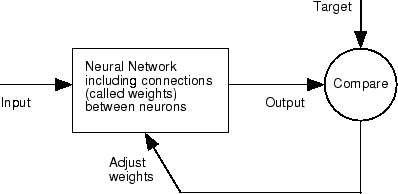用于模式识别、聚类和时间序列的浅层网络
神经网络由并行运行的简单元素组成。这些元素是受生物神经系统启发而设计的。本质上,元素之间的连接在很大程度上决定了网络的功能。您可以通过调整元素之间的连接(权重)值来训练神经网络以执行特定功能。
通常,我们需要对神经网络进行调整或训练,以使特定输入产生特定目标输出。下图说明了这种情况。此处,基于输出和目标的比较来调整网络,直到网络输出与目标匹配。通常,训练网络需要许多这样的输入/目标对。

神经网络已训练成在各个领域执行复杂功能,包括模式识别、标识、分类、语音、视觉和控制系统。
还可以训练神经网络来解决传统计算机或人类难以解决的问题。本工具箱强调神经网络范式的使用,这些范式是为工程、金融和其他实际应用而构建,或者它们本身投入这些应用。
以下主题说明如何以交互方式训练浅层神经网络,以解决函数拟合、模式识别、聚类和时间序列中的问题。使用这些工具可以让您很好地了解 Deep Learning Toolbox™ 软件的使用:
提示
要以交互方式构建和可视化深度学习神经网络,请使用深度网络设计器。有关详细信息,请参阅深度网络设计器快速入门。
Deep Learning Toolbox 中的浅层网络 App 和函数
可以通过四种方法来使用 Deep Learning Toolbox 软件。
第一种方法是通过其工具。使用这些工具可以便捷地访问工具箱功能,以执行以下任务:
使用工具箱的第二种方法是通过基本的命令行操作。相比工具而言,命令行操作提供了更大的灵活性,但也增加了一些复杂性。如果这是您第一次使用本工具箱,使用工具是最佳的入门选择。此外,使用工具可以生成正规 MATLAB® 代码的脚本,您可以将其作为模板来创建自定义命令行函数。先使用工具,再生成和修改 MATLAB 脚本,这一过程是了解工具箱功能的绝佳方式。
使用工具箱的第三种方法是通过自定义。该高级功能允许您创建自己的自定义神经网络,同时仍可以使用工具箱的完整功能。您可以创建具有任意连接的网络,并且仍然能够使用现有工具箱训练函数来训练它们(只要网络组件是可区分的即可)。
使用工具箱的第四种方法是修改工具箱中包含的任一函数。每个计算组件均以 MATLAB 代码编写,并且完全可访问。
这四个级别的工具箱使用方法满足了从新手到专家的不同用户的需求:简单的工具通过特定应用情形引导新用户,而网络自定义则使研究人员能够以最少的工作量尝试新架构。无论您的神经网络和 MATLAB 知识水平如何,都有适合您需求的工具箱功能。
自动脚本生成
这些工具本身是 Deep Learning Toolbox 软件学习过程的重要组成部分。它们引导您完成神经网络的设计过程,以解决四个重要应用领域的问题,而又不要求您在神经网络或 MATLAB 使用方面具备深厚的背景知识。此外,这些工具还可以自动生成简单和高级 MATLAB 脚本,这些脚本可以重现工具执行的步骤,但您可以选择覆盖默认设置。这些脚本可以提供用于创建自定义代码的模板,并且可以帮助您熟悉工具箱的命令行功能。强烈建议您使用这些工具的自动脚本生成工具。
Deep Learning Toolbox 应用
我们无法为您一一列举神经网络已提供出色解决方案的所有应用领域。本主题后续部分只介绍函数拟合、模式识别、聚类和时间序列分析领域的部分应用情形。下表列出了神经网络丰富多样的前沿应用。
行业 | 业务应用 |
|---|---|
航空航天 | 高性能飞机自动驾驶仪、飞行路径仿真、飞机控制系统、自动驾驶仪增强、飞机部件仿真和飞机部件故障检测 |
汽车 | 汽车自动导航系统和保修活动分析 |
银行 | 支票和其他单据阅读及信贷申请评估 |
国防 | 武器操纵、目标跟踪、物体甄别、人脸识别、新型传感器、声纳、雷达,还有包括数据压缩、特征提取和噪声抑制以及信号/图像识别在内的图像信号处理 |
电子 | 代码序列预测、集成电路芯片布局、工艺控制、芯片故障分析、机器视觉、语音合成和非线性建模 |
娱乐 | 动画、特效和市场预测 |
金融 | 房地产评估、贷款顾问、抵押贷款筛选、公司债券评级、信用额度使用分析、信用卡活动跟踪、投资组合交易计划、公司财务分析和货币价格预测 |
工业 | 工业流程预测,如输出炉气,以此替代过去为此目的使用的复杂而昂贵的设备。 |
保险 | 保单申请评估和产品优化 |
制造 | 制造工艺控制、产品设计和分析、工艺和机器设备诊断、实时粒子识别、视觉质量检测系统、啤酒测试、焊接质量分析、纸张质量预测、计算机芯片质量分析、研磨操作分析、化工产品设计分析、机器设备维护分析、工程投标、规划和管理以及化工流程系统动态建模 |
医疗 | 乳腺癌细胞分析、脑电图和心电图分析、假体设计、移植时间优化、住院费用降低、医疗服务质量改善和急诊室检查建议 |
石油和天然气 | 勘探 |
机器人 | 轨迹控制、叉车机器人、机械手控制器和视觉系统 |
证券 | 市场分析、自动债券评级和股票交易咨询系统 |
语音 | 语音识别、语音压缩、元音分类和文本到语音合成 |
电信 | 图像和数据压缩、自动化信息服务、口语实时翻译和客户支付处理系统 |
交通 | 卡车制动诊断系统、车辆调度和路线规划系统 |
浅层神经网络设计步骤
在本主题的其余部分,您将遵循设计神经网络的标准步骤来解决四个应用领域的问题:函数拟合、模式识别、聚类和时间序列分析。解决这些问题的工作流都包含七个主要步骤。(步骤 1 中的数据采集虽然重要,但通常在 MATLAB 环境外部进行。)
收集数据
创建网络
配置网络
初始化权重和偏置
训练网络
验证网络
使用网络
在以下各节中,您将使用 GUI 工具和命令行操作来执行这些步骤:
另请参阅
神经网络拟合 | 神经网络时间序列 | 神经网络模式识别 | 神经网络聚类 | 深度网络设计器 | trainlm | fitnet